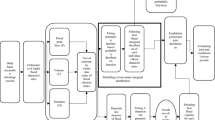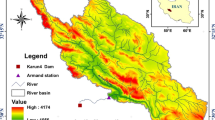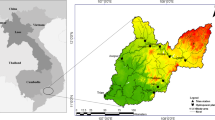Abstract
Floods are disastrous events in nature. In order to minimize the loss caused by these inevitable events, there is a need to estimate the risk of their occurrences. Several attempts have been made to study flood data in different parts of the world. In this paper, bivariate analysis of flood frequency using Archimedean copula is carried out on Sukkur Barrage, Indus River, Pakistan. The important characteristics of floods, namely peak flow and volume, are mutually dependent on each other. Copula-based technique to capture scale-free dependence structure is the most common technique meant for multivariate analysis of flood data. It is easy to construct and is a powerful technique for choice of marginal distributions. There are many types of Archimedean copulas selected for Archimedean copulas which have been tested on peak-flow and volume in the inflow data of Sukkur barrage, and in the light of graphical and statistical tests, Gumbel-Hougaard copula has been found to be the most appropriate one for the data under consideration. The Gumbel-Hougaard copula is used for obtaining primary and conditional return periods of flood characteristics. It also gives the Kendall return period for the multivariate analysis, which can be useful for risk based design of water resources project.








Similar content being viewed by others
References
Ahmad I, Fawad M, Akbar M, Abbas A (2016) Regional frequency analysis of annual peak flows in Pakistan using linear combination of order statistics. Pol J Environ Stud 25:1–10
Ariff NM, Jemain AA, Ibrahim K, Zin WZW (2012) IDF relationships using bivariate copula for storm events in peninsular Malaysia. J Hydrol 470:158–171
Balistrocchi M, Bacchi B (2011) Modeling the statistical dependence of rainfall event variables through copula functions. Hydrol Earth Syst Sci 15:1959–1977
Corbella S, Stretch DD (2013) Simulating a multivariate sea storm using Archimedean copulas. Coast Eng 76:68–78
D'Amico G, Petroni F, Prattico F (2015) Wind speed prediction for wind farm applications by extreme value theory and copulas. J Wind Eng Ind Aerodyn 145:229–236
De Michele C, Salvadori G, Canossi M, Petaccia A, Rosso R (2005) Bivariate statistical approach to check adequacy of dam spillway. J Hydrol Eng ASCE 10(1):50–57
De Michele C, Salvadori G, Passoni G, Vezzoli R (2007) A multivariate model of sea storms using copulas. Coast Eng 54:734–751. https://doi.org/10.1016/j.coastaleng.2007.05.007
Favre AC, El Adlouni S, Perreault L, Thiemonge N, Bobee B (2004) Multivariate hydrological frequency analysis using copulas. Water Resour Res 40. https://doi.org/10.1029/2003wr002456
Fisher NI, Switzer P (1985) Chi-plots for assessing dependence. Biometrika 72:253–265
Frahm G, Junker M, Schmidt R (2005) Estimating the tail-dependence coefficient: properties and pitfalls. Insurance: Mathematics and Economics 37:80–100
Ganguli P, Reddy MJ (2013) Probabilistic assessment of flood risks using trivariate copulas. Theor Appl Climatol 111:341–360
Genest C, Boies JC (2012) Detecting dependence with Kendall plots. Am Stat 57:275–284
Genest C, Favre AC (2007) Everything you always wanted to know about copula modeling but were afraid to ask. J Hydrol Eng 12:347–368. https://doi.org/10.1061/(asce)1084-0699(2007)12:4(347)
Genest C, Rivest LP (1993) Statistical inference procedures for bivariate Archimedean copulas. J Am Stat Assoc 88:1034–1043
Genest C, Rémillard B, Beaudoin D (2009) Goodness-of-fit tests for copulas: A review and a power study. Insurance Math. Econom. 44:199–213
Graler B, van den Berg MJ, Vandenberghe S, Petroselli A, Grimaldi S, De Baets B, Verhoest NEC (2013) Multivariate return periods in hydrology: a critical and practical review focusing on synthetic design hydrograph estimation. Hydrol Earth Syst Sci 17:1281–1296. https://doi.org/10.5194/hess-17-1281-2013
Gringorten II (1963) A plotting rule for extreme probability paper. J Geophys Res 68:813–814
Hofert M, Kojadinovic I, Maechler M and Yan J (2016) copula: Multivariate dependence with copulas. R package version 0.999–15. URL: http://CRAN.Rproject.org/package=copula
Hosking JRM, Wallis JR (1997) Regional frequency analysis-an approach based on L-moments. Cambridge University Press, Cambridge
Karmakar S, Simonovic SP (2008) Bivariate flood frequency analysis: part 1. Determination of marginals by parametric and nonparametric techniques. J Flood Risk Manag 1:190–200
Kumar S, Roshni T, Himayoun D (2019) A comparison of emotional neural network (ENN) and artificial neural network (ANN) approach for rainfall-runoff modelling. Civ Eng J 5(10). https://doi.org/10.28991/Cej2019-03091398
Lal M, Lashari BK, Laghari KQ (2011) Flood frequency analysis of main Nara valley. Mehran Univ Res J Eng Technol 30:125–134
Li F, Zheng Q (2016) Probabilistic modeling of flood events using the entropy copula. Adv Water Resour 97:233–240
Ma MW, Song SB, Ren LL, Jiang SH, Song JL (2013) Multivariate drought characteristics using trivariate Gaussian and student t copulas. Hydrol Process 27:1175–1190
Madadgar S, Moradkhani H (2013) A Bayesian framework for probabilistic seasonal drought forecasting. J Hydrometeorol:1685–1170. https://doi.org/10.1175/JHM-D-13-010.1
Michiels F, De Schepper A (2008) A copula test space model how to avoid the wrong copula choice. Kybernetika 44:864–878
Mohammed MP (2019) River flood hazard modeling: forecasting flood hazard for disaster risk reduction planning. Civ Eng J 5(11)
Naz S, Iqbal MJ, Akhter SM, Hussain I (2016) The Gumbel Mixed Model for Flood Frequency Analysis of Tarbela. The Nucleus 53:171–179
Nelsen RB (2007) An introduction to copulas. Springer Science & Business Media
Parajka J, Pepe M, Rampini A, Rossi S, Blöschl G (2010) A regional snow line method for estimating snow cover from MODIS during cloud cover. J Hydrol 381:203–212. https://doi.org/10.1016/j.jhydrol.2009.11.042
Poulin A, Huard D, Favre A-C, Pugin S (2007) Importance of tail dependence in bivariate frequency analysis. J Hydrol Eng 12(4):394–403. https://doi.org/10.1061/(ASCE)1084-0699(2007)12:4(394)
Rao AR, Hamed KH (2000) Flood frequency analysis. CRC Press, Boca Raton, FL
Requena AI, Mediero Orduña L, Garrote de Marcos L (2013) A bivariate return period based on copulas for hydrologic dam design: accounting for reservoir routing in risk estimation. Hydrol Earth Syst Sci 17:3023–3038. https://doi.org/10.5194/hess-17-3023-2013
Salvadori G, De Michele C (2004) Frequency analysis via copulas: theoretical aspects and applications to hydrological events. Water Resour Res 40(65):16 of 12. https://doi.org/10.1029/2004WR003133
Salvadori G, De Michele C (2010) Multivariate multiparameter extreme value models and return periods: a copula approach. Water Resour Res 46. https://doi.org/10.1029/2009WR009040
Salvadori G, De Michele C, Kottegoda NT, Rosso R (2007) Extremes in nature an approach using copulas. Springer, Dordrecht
Salvadori G, Durante F, De Michele C (2011) On the return period and design in a multivariate framework. Hydrol Earth Syst Sci 15:3293–3305. https://doi.org/10.5194/hess-15-3293-201
Sklar A (1959) Fonctions de répartition à n dimensions et leurs marges. Publications de l’Institut de Statistique de L’Université de Paris 8:229–231
Sraj M, Bezak N, Brilly M (2015) Bivariate flood frequency analysis using the copula function: a case study of the Litija station on the Sava River. Hydrol Process 29:225–238. https://doi.org/10.1002/hyp.10145
Vandenberghe S, Verhoest NEC, Onof C, De Baets B (2011) A comparative copula-based bivariate frequency analysis of observed and simulated storm events: a case study on Bartlett-Lewis modeled rainfall. Water Resour Res 47. https://doi.org/10.1029/2009wr008388
Wong G, van Lanen HAJ, Torfs P (2013) Probabilistic analysis of hydrological drought characteristics using meteorological drought. Hydrol Sci J 58:253–270
Yue S, Ouarda TBMJ, Bobée B, Legendre P, Bruneau P (1999) The Gumbel mixed model for flood frequency analysis. J Hydrol 226:88–100
Yue S (2001) A bivariate extreme value distribution applied to flood frequency analysis. Nord Hydrol 32:49–64. https://doi.org/10.2166/nh.2001.0004
Zhang L (2005) Multivariate hydrological frequency analysis and risk mapping (Doctoral dissertation, Beijing Normal University)
Zhang L, Singh VP (2007) Trivariate flood frequency analysis using the Gumbel– Hougaard copula. J Hydrol Eng 12:431–439. https://doi.org/10.1061/(ASCE1084-0699(2007)12:4(431)
Acknowledgments
We are thankful to Mr. Shahbaz Akhter, Civil Engineer of Sindh Irrigation Department, Government of Sindh, Karachi for providing us with data used in this work and his kind support.
Author information
Authors and Affiliations
Corresponding author
Additional information
Responsible Editor: Broder J. Merkel
Rights and permissions
About this article
Cite this article
Naz, S., Jamil, S.S. & Iqbal, M.J. Archimedean copula-based bivariate flood-frequency analysis on Sukkur, Pakistan. Arab J Geosci 13, 282 (2020). https://doi.org/10.1007/s12517-020-5223-1
Received:
Accepted:
Published:
DOI: https://doi.org/10.1007/s12517-020-5223-1




